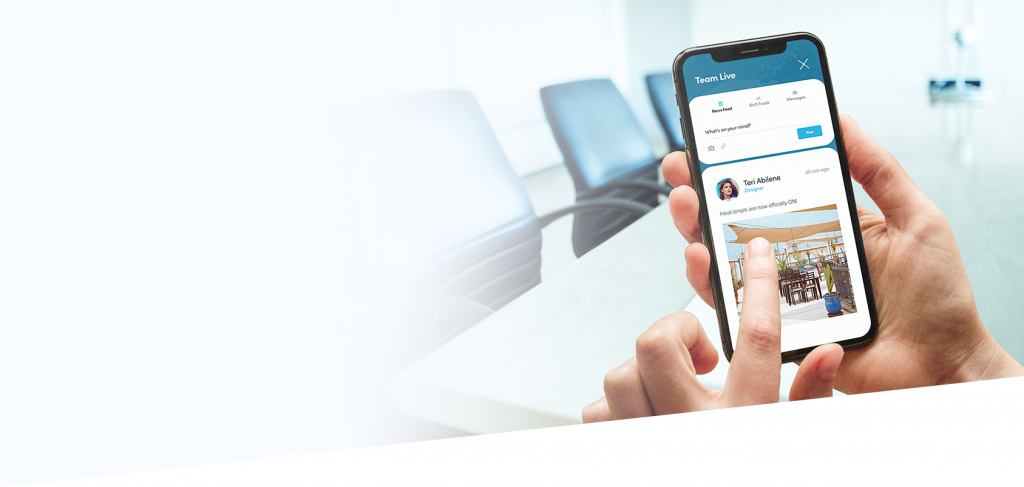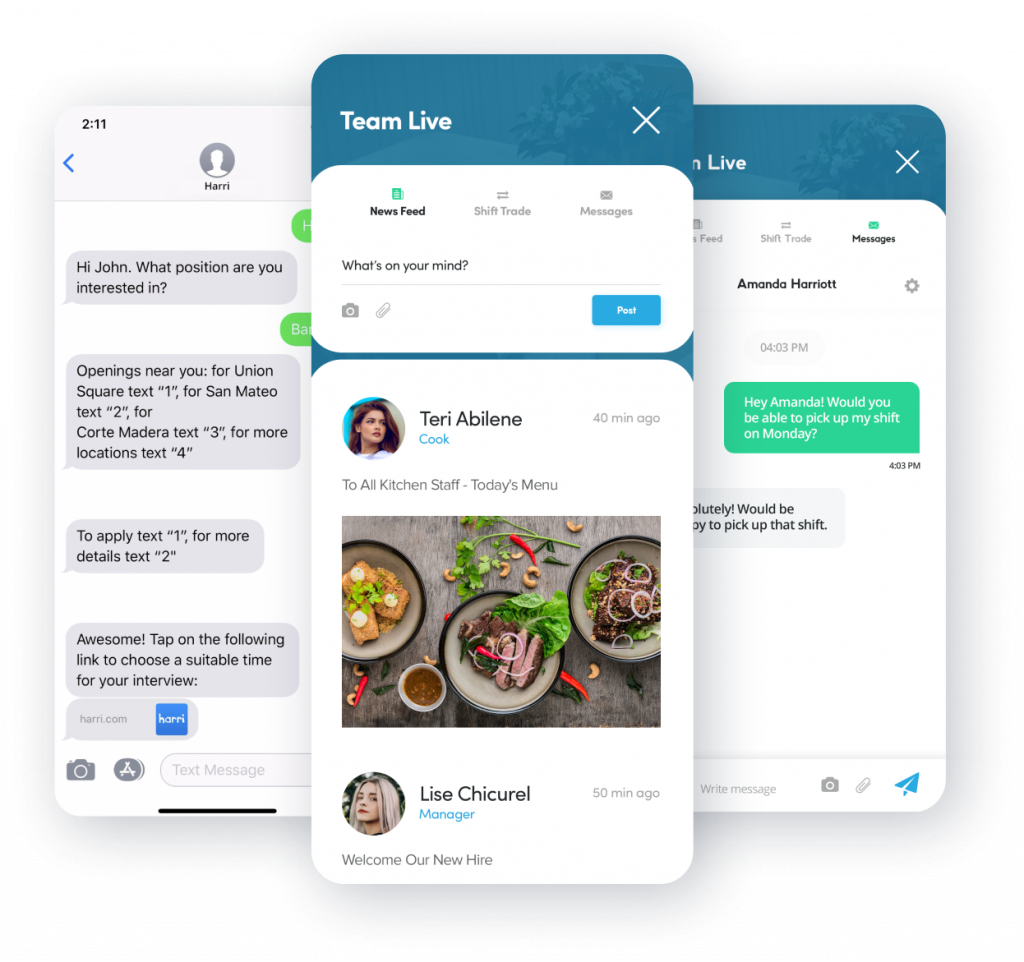Driving Workplace Collaboration with Team Communications Tools

- By Harri Insider Team | August 10, 2023
If you talk to any CEO or business owner about their top secrets to success, each person will have different answers, but one thing they all have in common? Good communication. Without effectively communicating with their teams, their managers, their Human Resources department, and employees at all levels, business will stagnate or fall apart entirely. That’s why all companies of any size need to have the right team communication tools in place.
Whether you use an employee communication app or good old-fashioned email and announcements, teams need a system that allows for the sharing of important news, facilitates discussion when there is a problem, allows for employees to request documented time off, and helps workers on different schedules engage. Even if you have processes that work in an evolving employment landscape that now includes remote workers, we have to consistently revisit those processes to make sure they grow with your company and continuously meet its needs.
The Changing Landscape of Workplace Communication
Before technology became so advanced, businesses could safely rely on bulletin boards, group emails, and email chat windows, in addition to in-person meetings. These approaches worked, but they also left problematic gaps and didn’t have a safety net in the event someone didn’t have email access outside of work. Once companies started allowing remote work, an oft-requested exception prior to the pandemic that became the norm in many industries even after it was safe to return to work, even more gaps in old-school communication systems became evident. This was the push many businesses needed to make a change and seek out the most fitting team communication tools for their business.
While many people in the hospitality industry cannot work from home, the need for a fully electronic communication system still became critical. Employees no longer work just in the immediate locale of their residence, and travelers and guests have a renewed interest in travel, bringing with them a higher set of expectations. To adequately ensure the proper guest experience, businesses must attack the problem proactively by updating their systems before problems occur.

Role of Digital Tools in Fostering Collaboration and Productivity
Emails are still a critical part of any business, but the dreaded reply-all is a time waster, not to mention a problem waiting to occur if someone shares sensitive information publicly. Internal messaging systems go a lot further in maintaining privacy while providing organization and tracking communications for historical purposes.
Real-time messaging is no longer an option but a necessity. A group scattered in various franchise locations no longer needs to jump on Zoom; they can have an immediate group discussion from wherever they are, all courtesy of that employee communication app. Everyone is witness to what others have contributed to the conversation, and the app stores the conversations in perpetuity, allowing everyone to search the app for reference at a later time.
When a team works different hours and needs to have an employee meeting, these messaging options allow for them to come together cohesively with as little interruption as possible. Gone are the days of looking in multiple places to find out if someone’s working that day and if they know where a specific piece of documentation is. We’ve all experienced being left out of an email chain or meeting in error, only finding out too late that hours have changed, we’ve got a special guest visiting, or that we’re celebrating Mary’s birthday in the break room at noon – because communication isn’t just for the serious things, but for the small touches that make employees feel as though they’re a valued part of the team.
Every communication app is a little different, so having a customizable tool means you have a system that meets all your business’s needs, ramping up productivity while saving time and money. This means your business performance improves while making work life easier for all of your employees, from the CEO to the part-time seasonal staff.
Key Features to Look for in a Team Communication Tool
So what makes a good team communication tool? First, start with a perusal of your current system. What is working? What isn’t working? Where are there gaps, and what is not working for your employees? Look back on problems you’ve experienced and consider what type of tool would prevent them from recurring. Use this data to decide what you need.
Here are a few possibilities to consider as mission-critical options:
Customizable group and individual options: you can add any/all employees to a group chat or send private messages that no one else can see. These message groups are similar to what is referred to as a “channel” or “forum” in other messaging tools. One popular way to use these is to add one group for each department or shift. A manager can reach out to everyone in a particular area in moments. Live collaboration will be right at your fingertips!
News Feeds: envision these as your podium, a place to share news that’s relevant to everyone in your company. It’s almost like a social media platform feed, but only for your company! You can welcome new employees, announce the opening of a new location, list any positions you may need to fill, recognize outstanding achievements, or thank your team for meeting new goals or breaking records. The opportunities for a news feed are endless, and this tool encourages inclusion and makes it difficult for anyone to miss important things, as you can remind employees it is their responsibility to check the feed frequently. You can even add media – images, files, etc. – to your feed and messages, so employees only need to look in one location to get all the information they need.
Need to drill a little deeper and have smaller groups? Set up your news feeds to reach only employees in specific roles, certain locations, or even new employees still in the onboarding process.
Multi-Channel Notifications: while it’s nice to have everything in one place within the app, some systems, like Harri, will offer you the option to use push notifications, so things you share in the feed or in a message group also get sent to an email group or even texts.
Team Hub: many businesses in the hospitality industry are large and in constant growth, and employees won’t all have the opportunity to speak with each other when they need to. A communication application empowers your employees to be able to share feedback and customer testimonials. Some employees may feel out of the loop if they’re working in a slower location or in a busier role that makes it difficult for them to reach out as necessary; others may feel intimidated. Having a TeamHub gives them a space to conveniently reach out while also providing you a space to share new menu items, special events, and more. Management transparency is something employees respect and need, and this space feels as close to a human conversation as electronics will provide.

Navigating the Shift to Digital with Employee Communication Apps
Starting anew with any of the many team communication tools can seem overwhelming, but it’s a shift that will pay off in a big way. Reviewing options, setting up your choice, and customizing it is a one-time thing; then you can make adjustments or add options as time goes on. Spend some time getting to know it, then present it to your employees by highlighting all the perks. The fact that they can access these tools on their iPhone or Android means they can potentially login and use the tool from anywhere.
One big perk is problem resolution when an employee is unable to come to work on a last-minute notice. A Communication platform or small group messaging system means you can post about a shift that needs to be filled, leaving it open to anyone available on a first-come, first-served basis. It fills your empty schedule quickly and it’s an inclusive way to offer additional hours. This is just one of many examples of the bonuses of utilizing an easy system that is accessible to everyone.
Another perk is documentation. Communication is immediate but can be edited, and edits are tracked. This decreases the likelihood of miscommunication or confusion. Clear, quick, and efficient communication helps launch your business forward so everyone can focus on doing their jobs knowing that the mechanics of employee problems and staff discussions are handled, yet available as a resource at any time in the future.
The Future is Collaborative with Harri
There is an array of team communication tools out there, but Harri rises above the rest with its focus on the hospitality industry and intuitive user experience. Harri knows what you need and has created a tool made to address the situations that are unique to the particular issues that a hospitality business faces. Knowing you’re working with a company designed to help you is reason enough to put it at the top of your list.
If you’re interested in trying it out yourself, sign up for a free demo here. Harri’s employee communication app is reliable and heavily customizable. You can streamline and unify your team’s communications with one tool, but if you also want to add in talent acquisition, such as hiring and onboarding, Harri offers that, too.




















